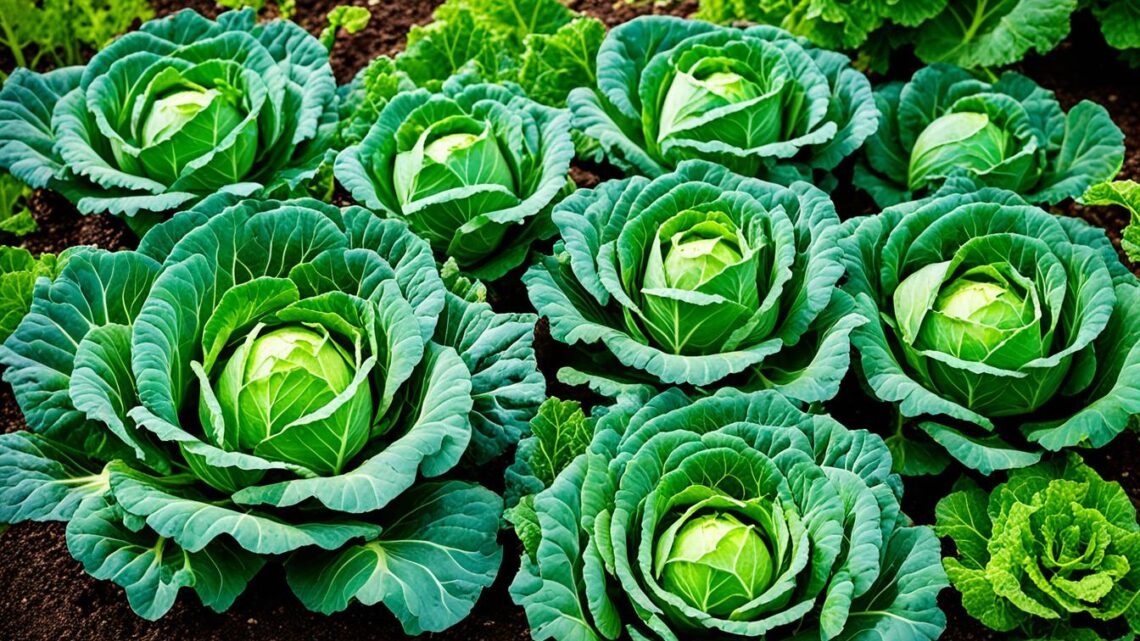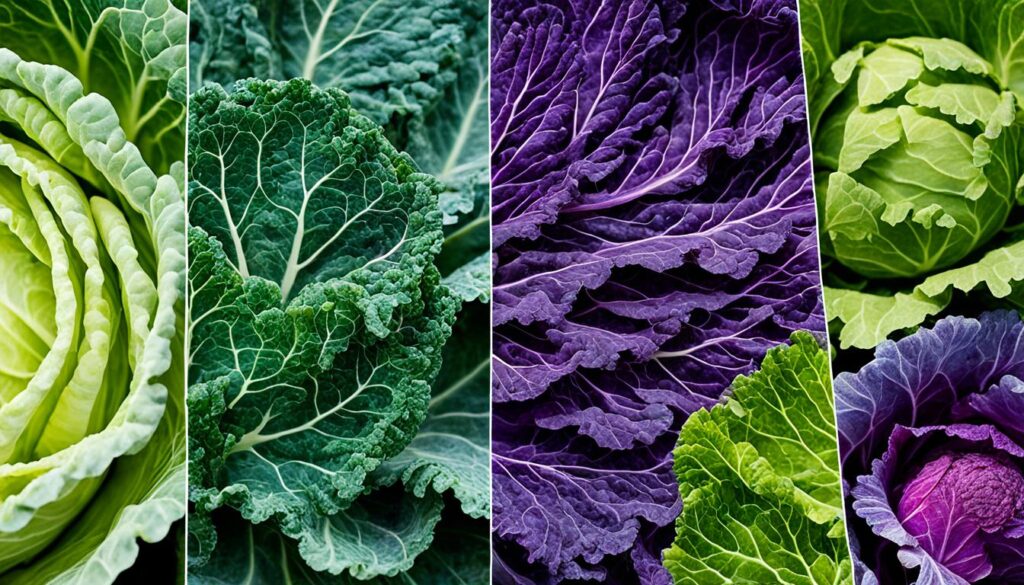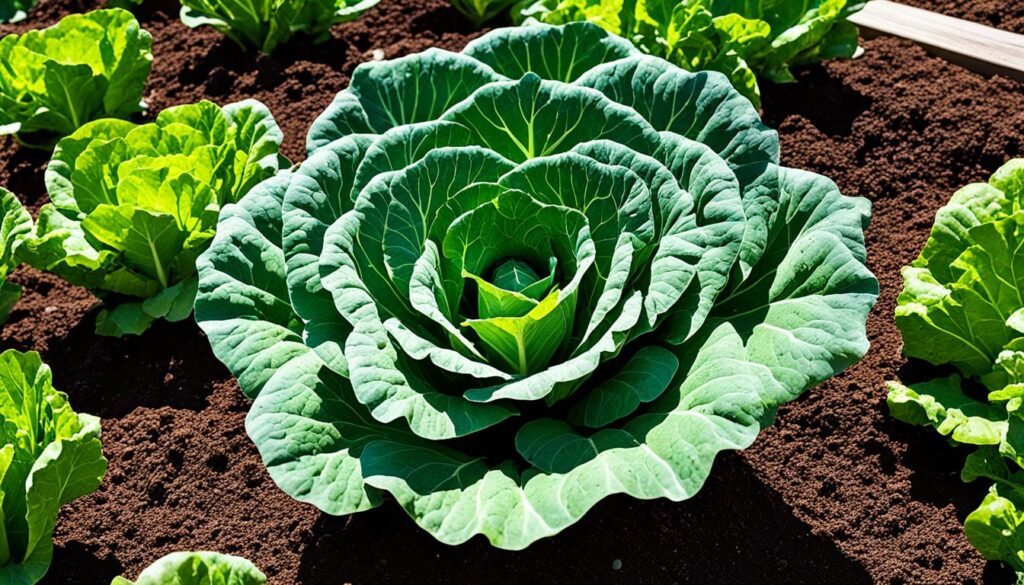
Do you know the secret to making the most of this simple yet versatile vegetable? Cabbages are more than just a common ingredient in traditional dishes. They are a nutritional powerhouse that can boost your health and garden. This guide will show you the amazing world of cabbages. It will help you grow and enjoy these leafy greens fully.
Cabbages belong to the Brassica oleracea species and are part of the cruciferous vegetable family. This family also includes broccoli, kale, and Brussels sprouts. These greens are known for their rich nutrients, versatility in cooking, and ability to grow in many climates. This guide is for anyone who wants to get the most out of this tough, tasty crop.
The Versatile and Nutritious Cabbage
Cabbage is more than just a simple leafy green. It’s a powerhouse of nutrients packed into a versatile vegetable. This low-calorie, high-fiber vegetable is full of vitamins, minerals, and antioxidants. It’s a great addition to a nutrient-dense produce diet.
Cabbage’s Impressive Nutrient Profile
Cabbage is a great source of vitamin K. Just one cup gives you 56% of your daily value. It also has 36% of the DV for vitamin C, 10% for folate, and lots of manganese, vitamin B6, thiamin, pantothenic acid, calcium, magnesium, potassium, and riboflavin. This antioxidant-rich food is a nutritional powerhouse.
Versatility in the Kitchen
Beyond its impressive nutrients, cabbage is very versatile in the kitchen. This high-fiber food fits into many dishes. From classic low-calorie foods like coleslaws and salads to hearty soups, stir-fries, and fermented favorites like sauerkraut. Its crisp texture and mild flavor make it great for raw, cooked, or pickled dishes.
If you want to boost your nutrient-dense produce intake or try new tasty ways to enjoy this cruciferous vegetable, cabbage is a great choice. It’s a kitchen star worth adding to your meals.

Cabbages: Varieties to Explore
The cabbage family has many varieties, each with its own taste and uses. From the classic green to the vibrant red and the delicate savoy, there’s a cabbage for everyone. Each type suits different tastes and cooking ways.
Green Cabbage
Green cabbage is the most common type. It tastes mild and slightly sweet, with firm heads. It’s great for shredding into coleslaw, fermenting, or braising.
Red Cabbage
Red cabbage is known for its bright purple-red color. It tastes slightly peppery, making it perfect for salads and slaws. The color changes with the soil’s pH, turning reddish in acidic soil and purplish in neutral soil.
Savoy Cabbage
Savoy cabbage has tender, crinkled leaves and a sweeter taste. It’s great for sautéing, steaming, or salads. But, it doesn’t last as long as green and red cabbages.
Napa Cabbage
Napa cabbage, also called Chinese cabbage, has a crisp, mild flavor. It’s often used in Asian dishes, like kimchi. There are over 180 kimchi types, with baechu-kimchi being very popular.

Whether you like the classic green, the bright red, the tender savoy, or the crisp napa, there’s a cabbage for you. Discover the many ways to use these nutritious vegetables in your cooking.
Planning Your Cabbage Garden
When to Plant Cabbage
Cabbage loves cool weather, growing best in temperatures between 45°F and 75°F. The best time to plant cabbage varies by your area and the type you grow.
For a summer crop, start cabbage seeds indoors in early spring or directly in the garden when the soil is ready. For fall, plant in mid-to-late summer, 10-12 weeks before frost. In places with mild winters, plant in late fall or early winter for a winter crop.
| Harvest Season | Planting Time |
|---|---|
| Summer | Early spring (start seeds indoors) or as soon as the soil can be worked |
| Fall | Mid-to-late summer, 10-12 weeks before the first expected frost |
| Winter | Late fall or early winter in mild-winter climates |
Cabbage seedlings do best in soil that’s 75 to 85°F. Plan well to get a great cabbage harvest all season.

Growing Cabbage: Step-by-Step
Growing your own cabbage is rewarding and gives you lots of this tasty vegetable. You can start with seeds or seedlings. Just follow a few steps for a great crop.
Start by planting seeds about 1/4 inch deep in containers or trays. When they grow to 4-6 inches, move them to your garden. Space them 12 to 24 inches apart for big, healthy heads.
Keeping your cabbage moist is key. Water them with about 2 inches of water per square foot weekly. Mulching helps keep the soil moist and stops weeds. Watch out for pests and diseases, and remove any bad leaves to keep your plants healthy.
For a healthy crop, use a nitrogen-based fertilizer (21-0-0) about four weeks after moving them outside. This gives them the nutrients they need to grow big and strong.
By following these steps for how to grow cabbage, growing cabbage from seed, transplanting cabbage seedlings, and caring for cabbage plants, you’ll get a lot of this tasty vegetable.
| Cabbage Variety | Maturity Timeline |
|---|---|
| Golden Acre | 65 days |
| Ruby Ball (red) | 55 days |
| Savoy Ace | 80 days |
| Danish Ball Head | 100 days |
Cabbages in Containers
Growing cabbages in containers is great for gardeners with little space. You can grow these versatile veggies on a small balcony, patio, or sunny windowsill. Let’s look at what you need for successful container-grown cabbages.
Container Size and Soil Needs
Size is important for growing cabbages in containers. Pick a big container that’s 12-18 inches deep and 16-20 inches wide. This gives the roots enough room to grow well. Fill it with a good potting mix that drains well and has lots of organic stuff in it.
Cabbages like soil that’s a bit acidic to neutral. The pH should be between 6.5 and 7.5.
Planting and Care
Put the cabbage seedlings or seeds in the container as the package says. Make sure the container gets at least 6-8 hours of sunlight a day. Keep the soil moist but don’t soak it, or the roots might rot.
Feed the plants with a balanced fertilizer to help them grow big and strong. This will make your cabbages taste better and grow more.
With the right container, soil, and care, you can grow tasty cabbages even in small spaces. Container gardening lets you enjoy fresh, homegrown cabbages. It opens up new possibilities in your kitchen.
Fertilizing Your Cabbage Crop
Cabbages need a lot of nutrients to grow big and strong. They are heavy feeders. Start with a balanced fertilizer, like a 10-10-10 mix, two weeks after you plant or thin the seedlings. This gives them the nutrients they need early on.
Later, give them a fertilizer high in nitrogen to help them grow their heads. But don’t give them more nitrogen once the heads are forming. Keep the soil moist and add organic stuff like compost to help them grow well all season.
It’s important to get the fertilizing right for your cabbages. Cabbages need certain nutrients and too much nitrogen can make them grow too much foliage. By choosing the right fertilizer and when to use it, you help your cabbages grow well.
| Fertilizer Type | Nutrient Ratio | Application Timing |
|---|---|---|
| Balanced Fertilizer | 10-10-10 | 2 weeks after transplanting or thinning |
| Nitrogen-rich Fertilizer | Variable | 3 weeks after initial application |
| Organic Fertilizers | Varies | Throughout the growing season |
To make sure your cabbages grow well, know about your soil’s fertility and what your cabbages need. Use nutrients in a balanced way at the right times. This will help your cabbages grow big and give you a lot of harvest.
Harvesting and Enjoying Your Cabbages
When it’s time to pick your cabbages, be patient and careful. Cabbages take 4 to 6 months to grow fully. Harvest them when they feel hard and solid.
Use a sharp knife to cut the stem 10 cm above the ground. Leave some stalk behind. This might help grow a second crop.
After picking, take out the stems and roots to stop diseases from spreading. You can keep your cabbages in the fridge for 1-2 weeks. Or store them in a cool, dry spot for months.
When you’re ready to eat them, just peel off the outer leaves. Enjoy your cabbages in dishes like coleslaw, salads, soups, and stews.
Cabbages are great for adding nutrition to your meals all year. With the right way to harvest and store, you can enjoy your cabbages for a long time.



